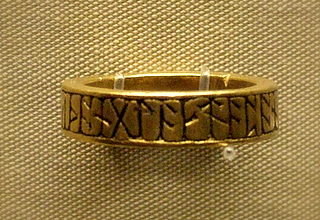There are seven known Anglo-Saxon Age rings inscribed in runes, one of which is now disintegrated:
1. Kingmoor, Carlisle. Chance find, 1817. Now in the British Museum. Gold with niello, c. 27 mm diameter; 9th century (according to David Wilson). It has thirty runes: 27 outside the hoop and 3 inside: + æ r k r i u f l t k r i u r i þ o n g l æ s t æ p o n | t o l. Bruce Dickins noted that the group of runes ærkriu is probably akin to ærcrio in a charm for stanching blood. Therefore the rings that contain this runic group are usually thought to be amulets (cf. Bramham Moor ring below). The inscriptions are interpreted as magical gibberish. The number thirty may also be seen as a magical number, ten times three.

Photo courtesy Kotomigd.
2. Wheatley Hill, Durham. Chance find, 1993. Now in the British Museum. Gilded silver alloy, c. 19 mm diameter; late 8th century. Old English runic inscription: [h]ring ic hatt[æ], ‘I am called a ring’.

3. Bramham Moor, Yorkshire. Chance find, before 1736. Now in Danish National Museum. Gold with niello, c. 29 mm diameter; 9th century. The runic inscription reads: æ r k r i u f l t || k r i u r i þ o n || g l æ s t æ p o nt o l.

4. Cramond, Edinburgh. Chance find in churchyard 1869-70. Now in the National Museum of Scotland. Leaded bronze, c. 22 mm diameter; 9th-10th century. The runic inscription uninterpreted: [.]ewor[.]el[.]u.
5. Thames Exchange, London. Metal-detector find 1989. Now in the Museum of London. Copper alloy, c. 15 mm diameter; date uncertain. The runic inscription probably contains a part of Futhorc and a personal name: [.]fuþni ine.
6. Linstock Castle, Cumbria. First mentioned in 1824. Now in the British Museum. Agate, c. 29 mm diameter, possibly 9th century. The runic inscription reads: e r y . r i . u f . d o l . y r i . þ o l . w l e s . t e . p o t e . n o l.
7. Coquet Island, Northumberland. Chance find, before 1866. Now disintegrated. Lead, c. 26 mm diameter, date uncertain. The Old English runic inscription read: + þis is -, ‘this is…’.

I see that you have included a copy of the full original rune for the Bramham Moor ring showing all runes in a continuous line in the original runic ‘font’
Do you know if the same is available anywhere for the Kingmoor ring, and if so, where would I find it?
An extremely interesting website. I am from London but have lived 20 years in central Finland
Magical engraved rings from this period and the Northern civilisations include many in Arabic or pseudo Arabic as well as the various runes. Both where the runic alphabets and Arabic alphabets are concerned, as many of the makers were not educated in those alphabets, the results often are not perfect, combining actual words or time-honoured spells with gibberish. I have a silver ring that dates from the 7th century with Arabic letters and pseudo Arabic.
Thank you so much for this site, I don’t know if it’s true that I from Anglo-Saxon decent but I have learned so much. THANK YOU
Hello Anzelle. You are welcome!